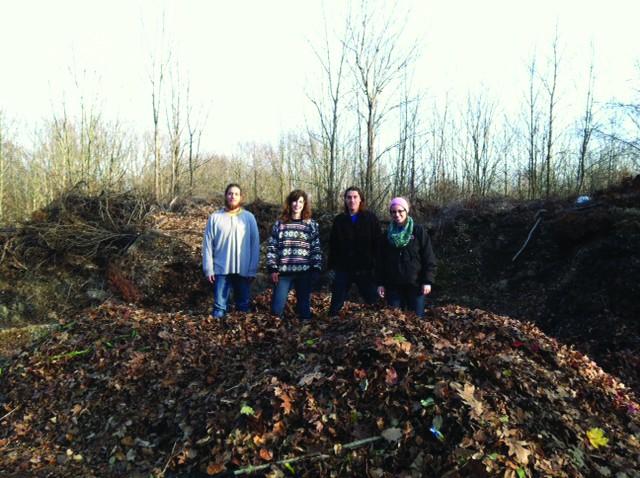Volunteers sort compost for windrows at SAP

Courtesy Photo / Jenny Jordan
Nov 18, 2012
Gwen Gell, a member of the Student Environmental Coalition, arrived Thursday at Grand Valley State University’s dump site to help separate compostable waste into three piles: ‘Green,’ ‘brown’ and ‘wood.’
“It’s a beautiful day, and it’s definitely for a good cause,” Gell said of spending the afternoon raking compost. “That pile of leaves looks really tempting.”
The pile of leaves she spoke of, which a few children could jump into at the same time with more than enough space for all of them, was just one of the two piles of ‘brown matter’ that the previous day’s volunteers had separated from the green matter and wood.
“The brown pile is mostly leaves and is the carbon source for (a) windrow,” said Bart Bartels, campus sustainability manager. “Grass and plant clippings make up the majority of the green pile (which provides nitrogen). The sticks and branches will be run through a wood chipper to provide mulch for landscaping and trails.”
Though it was mostly plant matter, the green pile also contained several large groups of orange pumpkins, as anything that is considered to be food is also considered ‘green’ in terms of composting.
Though GVSU has been dumping compostable waste at the site for years, none of the waste has previously been re-used, though doing so would reduce the amount of money the university spends on compost for the Sustainable Agriculture Project and the mulch spread around campus to help prevent weeds.
The compost sorted at the dump site will be used to create a windrow at the Sustainable Agriculture Project farm, just outside Allendale Campus.
“A windrow is a long pile of organic material,” Bartels said. “To windrow we will use three or four times more brown matter than green. With the right mixture, the interior of the pile will heat up to about 160 degrees, accelerating the decomposition rate of the material. When the interior starts to cool down, the pile can be flipped to restart the process, repeating until all the material is a healthy, rich soil.”
This entire process will take about a year to complete. The windrow that will be formed at the SAP farm will be eight to ten feet high and several yards long. The soil it will decompose into will be used to nourish the soil at the SAP farm.
Composting, however, is not always such a huge undertaking as the two-day project out at the dump site.
“I compost in my apartment,” said Natalie Stagner, an Allied Health Sciences major. “I find it important to close the loop.”
‘Closing the loop’ refers to the process of making the waste from one process into food for the next, and Stanger does this with her roommates by collecting compostable materials in a bin that, when full, is emptied into a biodegradable bag and put into the larger composting bin outside her housing unit.
Though this is the first time the Sustainable Agriculture Project has used GVSU compostable waste to nourish the farm’s soil, it will likely not be the last. This year was the first year in which Facilities Services, the Sustainable Community Development Initiative, and student volunteers came together in one large effort.
“Why haven’t we done it before?” Bartels said. ”We should have, just never did. We didn’t have enough people interested and motivated to do it.”
For more information about the Sustainable Agriculture Project, visit its website at http://www.gvsu.edu/sustainableagproject/.
[email protected]






















